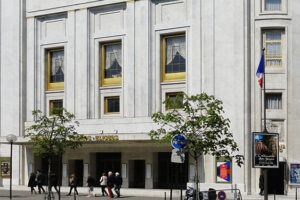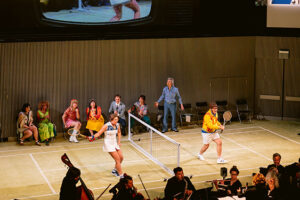
I have been a lifelong fan of West Side Story in spite, or because, of the fact that my first real introduction to its wonders was the bloated and bourgeois recording made by Leonard Bernstein and produced by Deutsche Grammophon in 1985. I can’t really be blamed since I was very young and impressionable and it was the first time I’d ever heard the musical numbers in full, like the balcony scene with the dialogue lead-in and the underscoring, as well as the dance music complete. It was, my friends, magic—even if Lenny, in a titanic display of nepotism, hired his own children to speak said love scenes to each other. (Ick.)
Truly he was acting out the role of simultaneous creator/destroyer of his own legacy with that recording. Casting, I’m sure partially dictated by DG, was perverse in the case of the three leads. In a show where you should at least be given the impression of youth, everyone sounded 50 years old. There’s also a fascinating documentary of the whole enterprise that shows Bernstein conducting with his cigarette, in rehearsal and performance, no matter the locale whether it be home or Manhattan recording studio.
West Side Story was so far ahead of its time it actually lost the Tony for Best Musical to Meredith Wilson’s The Music Man (How that must have hurt!) It’s a work loaded with quaint 1950s euphemisms in its dialogue that even Stephen Sondheim, its lyricist, admits to being embarrassed by at times. It could be looked at as America trying to shake off the end of that decade for the coming liberation of the 1960s. Unfortunately the youths comport themselves a bit like Damon Runyon hoodlums in a disingenuous bow to popular culture. There’s also the glossing over of the sexual assault of Anita in the “Jukebox/Taunting Scene” as another example of its creators pulling a punch on an Eisenhower era audience not ready to see reality.
Meanwhile I have always looked on the 1961 film as a near-total perversion for more reasons than can be recounted here.
I saw the national tour that ran for two years starting in 1997 on its stop here in Los Angeles. None other than Chita Rivera sat five rows ahead of me in the audience. Here’s me to my friend, ”Look at her hair?” My friend, ”It’s a wig”. What did I know? This production, with all of its original elements lovingly recreated; Jerome Robbins choreography, Oliver Smith’s sets by his own assistant of many years, and Irene Sharaff’s stunning costumes reconstructed by Barbara Matera, along with a very youthful and talented cast was nothing less than a revelation.
Meanwhile since the show’s debut there have been studio recordings galore, mostly jazz reimaginings, a quite good version with the lovely Barbara Bonney and Michael Ball that’s worth a listen even if, once again, everyone sounds too mature. The 2007 Decca Broadway 50th anniversary version authorised by the Bernstein Foundation finds a very (too) young Hayley Westenra and Vittorio Grigolo(!) as Maria and Tony desperately clutching towards an American idiom that just isn’t in their grasp. Total fail.
So if I fall on my knees before this new live recording issued by the San Francisco Symphony I’ll do my best to explain why as I weep copious tears of joy. Issued in a buckram-spined volume this 2-CD set is filled with photos, essays, an interview with its conductor, and even a reminiscence from Rita Moreno, who was invited to the performances. There’s an illustrated timeline of the musical’s history, all the lyrics printed in one language, and biographies of the cast. Remember, like in the old days?
Michael Tilson Thomas was a protégé of the master and was entrusted by the Bernstein Foundation to carry through with the concert performance/recording that had been planned of On The Town before Bernstein’s death in 1990. He’s no stranger to the idiom and he gets a whopping good performance out of his San Francisco Symphony which he’s been leading since 1995. The accusation could be levied that he’s being a tad careful here and there. But I think it’s more about a conductor wanting nothing to go for nothing. Not like, say, the guys who take two whole hours on the first act of Parsifal because they’re lost in their own glory. So much of this score is already ingrained in its audiences minds and I certainly don’t want to suggest we’re anything close to Wagnerian lethargy.
However, with the Symphony in the pit, there’s a lot to relish and Tilson Thomas makes certain we can. The overblown orchestrations for the film, that even Bernstein himself detested, have been eschewed for what is essentially the score for the Broadway show with the players just doubling on parts. Pieces like the “The Dance at the Gym” and “The Rumble” get the swing they need and flaunt that jazzy/Prokofiev influence that Bernstein cultivated.
The recording engineers do a magnificent job capturing the vibrant percussion section which is so important in this piece. The concert grand piano is being played with the lid off and its particular clang and strike made an enormous impression on me as well as cementing its place in the fabric of the orchestrations. The acoustic of the Marion Louise M. Davies Concert Hall is also one of the stars of this project. Outside of the cramped recording studios we’re used to this performance breathes rare air.
An uncommonly youthful sounding cast is lead by Cheyenne Jackson who is actually 39 years old. He still has a gorgeous and completely functional supported head voice which is a necessity for the role of Tony. He also sounds effectively believable as a young adult in the dialogue portions and some of his line readings (e.g., ”See only me” in the balcony scene) are very potent in their heartfelt simplicity. He also doesn’t ruin “Maria” with that completely misplaced B-flat that someone thought was a good idea once. There are some notes towards the top of the staff that find Mr. Jackson with an uncomfortably large spacing in his vibrato, a slight Broadway bark, but the majority of his singing is sweet and fresh and finds in him an ideal interpreter.
Alexandra Silber already has an impressive set of theatrical credentials and her voice finds that unique duality in being able to sing cleanly in the broadway style while keeping a healthy bloom on the top. Her Maria is charming and coquettish in “I Feel Pretty” and she keeps her Puerto Rican accent to a light suggestion. She’s also backed by a playfully understated trio of girlfriends who manage to avoid the trap of sounding like a gaggle of Tijuana streetwalkers unlike so many of their predecessors. The dialogue surrounding the aforementioned balcony scene and the dance at the gym is handled with just the right touch of naiveté.
Jessica Vosk makes a keen Anita, her moderately sized Broadway belt fitting well with the rest of the cast instead of the gallon jug contralto that’s been served up in this part too many times before in the recording studio. She’s just the right combo of cynical, sexy kitten in “America” and perfectly matches Silber in their 11-o’clock showdown, “A Boy Like That/I Have a Love.” The original lyrics for “America” are used, not the homogenized film rendition.
The Riff, Kevin Vortmann, partially masks his excellent voice and innate musicality behind the patois of the gang member and he’s crisp in the “Jet Song.” The ensemble junior thugs makes short and jolly work of “Gee, Officer Krupke” in Act II.
The absolute peak of this performance is the ensemble version of “Tonight” just before the end of Act I. Tilson Thomas and his orchestra drive the tempo as each layer of singers and players are added until we finally have Maria and Tony heroically capping, but not dominating, the ensemble. For one of the very few times in my life a recording gave me chills because of its emotional and musical balance.
“A Girl” is the nameless and faceless voice who sings the anthem “Somewhere” offstage during the Act II ballet. This role enjoys a unique pedigree starting with the chance casting of the young Reri Grist in the first Broadway company. Julia Bullock, who has not yet graduated Juilliard, holds her own quite well in that esteemed company with the voice and the words placed gently on the breath. She also ties a phrase or two together to ravishing effect. We’ll keep an eye on her.
Now I’m going to quibble a bit. Not on the performance but on the packaging and pricing. Yes, this performance is absolutely glorious and takes pride of place over all others, including the original cast album, as far as I’m concerned. However for all its beauteous packaging it prices on Amazon at nearly $40. It’s also spread out over two CDs with a total combined running time of 83 mins. This is hardly necessary and behooves the listener to change discs to enjoy the whole performance or more than one part of it. That said, if I’d known the performance enclosed therein was as good as it is I would have spent the money without hesitation.

























Comments